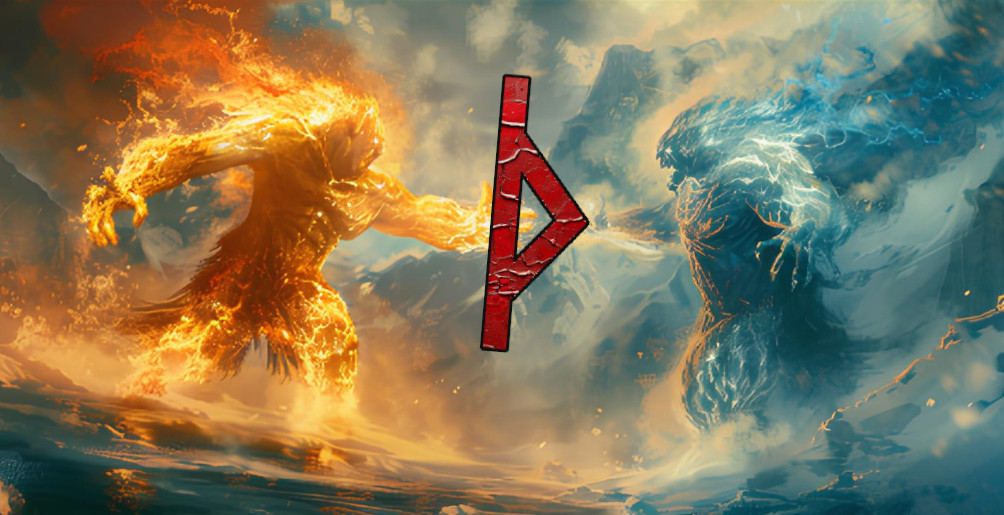ᚦ – Thurisaz or Thurs was called Thorn or “Þorn” in Anglo-Saxon England, and it is still used today as the Icelandic letter Þ (þ). In the Icelandic and Norwegian rune poems, the rune is called Thurs (Þurs). It has the sound value of a voiceless dental fricative /θ/ (the English sound of th as in thing).
It is the third rune of the proto-Germanic Futhark and thus the second rune of the Uthark. Its position as the second rune of the Uthark makes as much sense as Uruz being the first – when taking the Norse mythology into consideration.
This article is part of our exclusive series on the origins and secrets of the Nordic runes in the Elder Futhark and the merits of the intriguing Uthark theory proposed by the Swedish philologist Sigurd Agrell, professor at Lund University, Sweden.
The Uthark is a secret cipher, based on positioning the Fehu rune at the end of the rune row, like an ace in a deck of cards, revealing esoteric philosophy reaching deep into the heart of Norse culture and religious beliefs.
Meaning and interpretation
The rune symbolizes the thurses – the two terrifying races of giants, the Frost Giants and the Fire Giants – the two primal forces of chaos inhabiting the outer ends of the universe. Muspelheim, the world of fire and Nifelheim, the world of ice, are realms of extremes lying outside the order of the cosmos. The thurses are the anti-thesis, the opposite of the cosmic order, and they are often fighting with the gods.
These forces of chaos are frightening, but ultimately also necessary in the whole of creation because they are, in practice, driving the world forward and preventing it from becoming stagnant. On the one hand, the thurses are destroying the gods and their world, but on the other hand they also give the gods wisdom and enable the creation of new worlds.

From the chaotic realms of the Muspelheim and Nifelheim came terrifying creatures such as the Fenris Wolf, Fenrir, and the Midgard Serpent, Jörmungandr, but also mighty higher beings such as the Norns of Destiny.
Symbolism and magical use
Ambiguity is often associated with evil, as found in the various English words like two-faced, double-crossing, two-tongued, two-timing and so forth. The ambiguous Thurisaz is considered the rune of evil, witchcraft and black magic, but also one of the most, if not the most magical of all runes, with a flip side of wisdom and creation – just as is the case with the thurses.
Regarding magical numerology, gematria, Thurisaz appears in a magic spell recorded in an Icelandic black arts book from the 16th century, in which much of it seems to go back to ancient rune magic. The following magical recipe can be read there:
“Write these wands on white calfskin with your blood; take the blood on your thigh and say: I carve you eight Ansuz-runes, nine Nauthiz-runes, thirteen Thurisaz-runes.”
ᚨᚨᚨᚨᚨᚨᚨᚨᚾᚾᚾᚾᚾᚾᚾᚾᚾᚦᚦᚦᚦᚦᚦᚦᚦᚦᚦᚦᚦᚦ
Later, the purpose of the magical procedure is stated:
“Who must torment your belly with diarrhoea and weather tension (gas tension).”
Incidentally, it was this row of 8 ansuz runes, that also appears on the Lindholm amulet, an artifact to which we will return to later, that made Sigurd Agrell first start thinking about the Uthark theory.
Based on the Uthark, the gematria in the spell has several dimensions. First, 8 Ansuz runes in a row make 3 (third Uthark rune) times 8, which is 24.
Then there are 13 Thurisaz runes. There are also 9 runes of Nauthiz, which itself is rune number 9 in the Uthark. 9 is also, along with 24 and 13, the most significant and recurring gematrical number in rune magic, as we will explore further in the following article on the Ansuz rune.
Divination
Considered one of the most powerful runes, Thurisaz must be treated with the utmost respect. The rune is brutal and ruthless, though its power is not necessarily evil when it comes to divination.
The basics of rune divination
According to Norse belief, the runes represent aspects of the web of destiny, called the web of Urd (Wyrd). This web is intimately connected to time and the three Norns; Urd, Verdandi and Skuld. The Norns are weaving the threads of the web and represent what was, what is and what is to come.
The Roman historian Tacitus, among others, noted that rune divination was a widespread practice among the Norse. One of the most basic forms of such divination is to pray and draw three runes on twigs or cards which will signify the three Norns. By reading the web of Urd one may understand the present of Verdandi as well as the past, and also lift the veil of Skuld and see what lies hidden in the future.
When Thurisaz is upright in a runic reading, it often means that the questioner will be guided by the gods to act justly and ultimately will have their protection. It can also mean good luck and good news.
An upright Thurisaz can also be a sign that you are facing an important decision concerning your future. The rune does, however, encourage you to seek advice and wait before making it. You may even come to the conclusion that no decision should be made by you in this situation, and that Skuld, the Norn of Fate, will see that everything turns out for the best.
When Thurisaz is upside down, it is a serious warning against making any major decisions, or life changes, at this time. The upside-down position of the rune suggests that it is wiser to be cautious and wait than to rush into anything – or else possibly meet with misfortune.
Discover the following rune Ansuz – the rune of the gods
The Nordic Times


















